HYUNDAI GENESIS COUPE 2014 Repair Manual
Manufacturer: HYUNDAI, Model Year: 2014, Model line: GENESIS COUPE, Model: HYUNDAI GENESIS COUPE 2014Pages: 438, PDF Size: 40.35 MB
Page 61 of 438
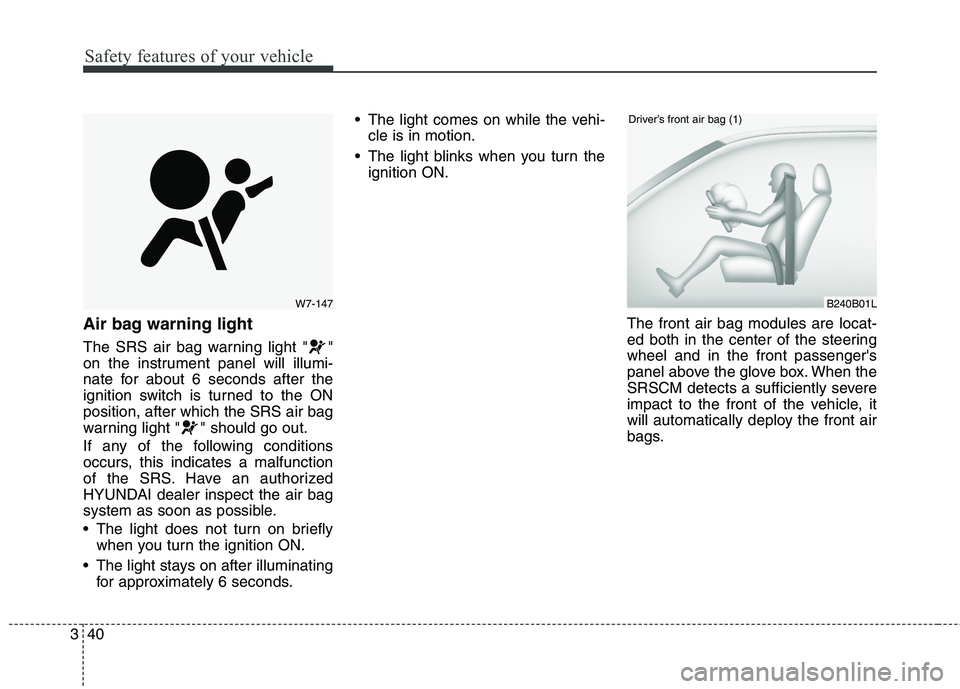
Safety features of your vehicle
40 3
Air bag warning light
The SRS air bag warning light " "
on the instrument panel will illumi-
nate for about 6 seconds after the
ignition switch is turned to the ON
position, after which the SRS air bag
warning light " " should go out.
If any of the following conditions
occurs, this indicates a malfunction
of the SRS. Have an authorized
HYUNDAI dealer inspect the air bag
system as soon as possible.
The light does not turn on briefly
when you turn the ignition ON.
The light stays on after illuminating
for approximately 6 seconds. The light comes on while the vehi-
cle is in motion.
The light blinks when you turn the
ignition ON.
The front air bag modules are locat-
ed both in the center of the steering
wheel and in the front passenger's
panel above the glove box. When the
SRSCM detects a sufficiently severe
impact to the front of the vehicle, it
will automatically deploy the front air
bags.
W7-147B240B01L
Driver’s front air bag (1)
Page 62 of 438
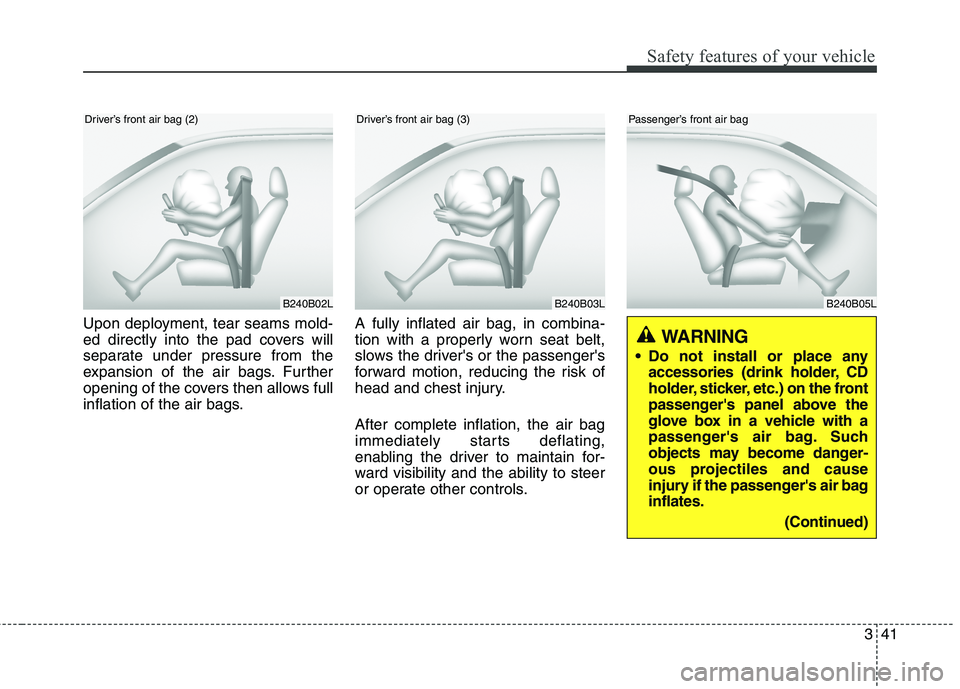
341
Safety features of your vehicle
Upon deployment, tear seams mold-
ed directly into the pad covers will
separate under pressure from the
expansion of the air bags. Further
opening of the covers then allows full
inflation of the air bags.A fully inflated air bag, in combina-
tion with a properly worn seat belt,
slows the driver's or the passenger's
forward motion, reducing the risk of
head and chest injury.
After complete inflation, the air bag
immediately starts deflating,
enabling the driver to maintain for-
ward visibility and the ability to steer
or operate other controls.
B240B02LB240B03L
Driver’s front air bag (2)Driver’s front air bag (3)
WARNING
Do not install or place any
accessories (drink holder, CD
holder, sticker, etc.) on the front
passenger's panel above the
glove box in a vehicle with a
passenger's air bag. Such
objects may become danger-
ous projectiles and cause
injury if the passenger's air bag
inflates.
(Continued)
B240B05L
Passenger’s front air bag
Page 63 of 438
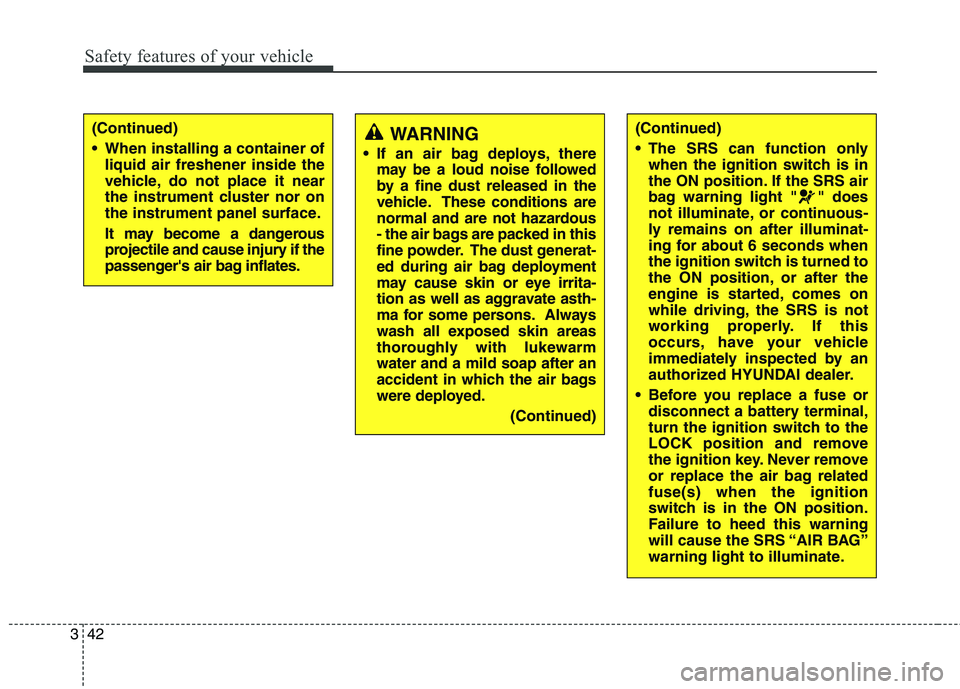
Safety features of your vehicle
42 3
WARNING
If an air bag deploys, there
may be a loud noise followed
by a fine dust released in the
vehicle. These conditions are
normal and are not hazardous
- the air bags are packed in this
fine powder. The dust generat-
ed during air bag deployment
may cause skin or eye irrita-
tion as well as aggravate asth-
ma for some persons. Always
wash all exposed skin areas
thoroughly with lukewarm
water and a mild soap after an
accident in which the air bags
were deployed.
(Continued)
(Continued)
The SRS can function only
when the ignition switch is in
the ON position. If the SRS air
bag warning light " " does
not illuminate, or continuous-
ly remains on after illuminat-
ing for about 6 seconds when
the ignition switch is turned to
the ON position, or after the
engine is started, comes on
while driving, the SRS is not
working properly. If this
occurs, have your vehicle
immediately inspected by an
authorized HYUNDAI dealer.
Before you replace a fuse or
disconnect a battery terminal,
turn the ignition switch to the
LOCK position and remove
the ignition key. Never remove
or replace the air bag related
fuse(s) when the ignition
switch is in the ON position.
Failure to heed this warning
will cause the SRS “AIR BAG”
warning light to illuminate.(Continued)
When installing a container of
liquid air freshener inside the
vehicle, do not place it near
the instrument cluster nor on
the instrument panel surface.
It may become a dangerous
projectile and cause injury if the
passenger's air bag inflates.
Page 64 of 438
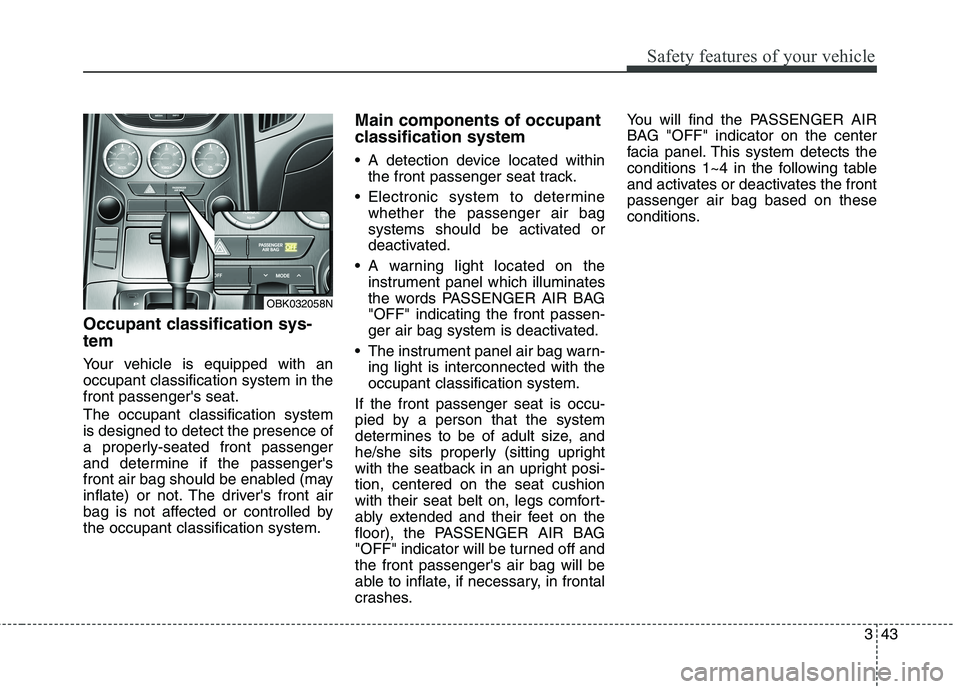
343
Safety features of your vehicle
Occupant classification sys-
tem
Your vehicle is equipped with an
occupant classification system in the
front passenger's seat.
The occupant classification system
is designed to detect the presence of
a properly-seated front passenger
and determine if the passenger's
front air bag should be enabled (may
inflate) or not. The driver's front air
bag is not affected or controlled by
the occupant classification system.
Main components of occupant
classification system
A detection device located within
the front passenger seat track.
Electronic system to determine
whether the passenger air bag
systems should be activated or
deactivated.
A warning light located on the
instrument panel which illuminates
the words PASSENGER AIR BAG
"OFF" indicating the front passen-
ger air bag system is deactivated.
The instrument panel air bag warn-
ing light is interconnected with the
occupant classification system.
If the front passenger seat is occu-
pied by a person that the system
determines to be of adult size, and
he/she sits properly (sitting upright
with the seatback in an upright posi-
tion, centered on the seat cushion
with their seat belt on, legs comfort-
ably extended and their feet on the
floor), the PASSENGER AIR BAG
"OFF" indicator will be turned off and
the front passenger's air bag will be
able to inflate, if necessary, in frontal
crashes.You will find the PASSENGER AIR
BAG "OFF" indicator on the center
facia panel. This system detects the
conditions 1~4 in the following table
and activates or deactivates the front
passenger air bag based on these
conditions.
OBK032058N
Page 65 of 438
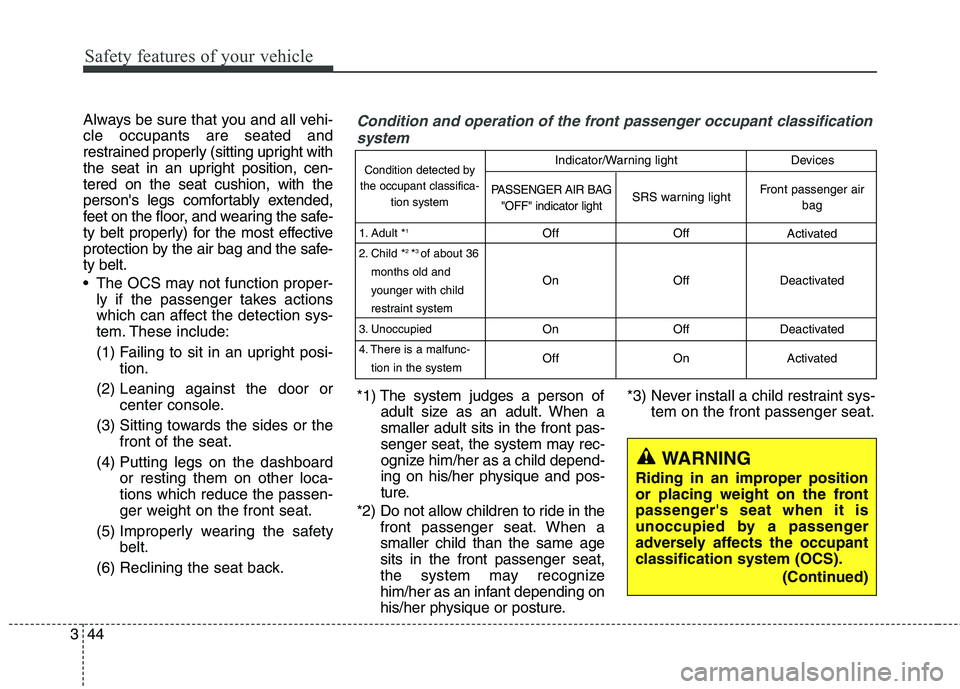
Safety features of your vehicle
44 3
Always be sure that you and all vehi-
cle occupants are seated and
restrained properly (sitting upright with
the seat in an upright position, cen-
tered on the seat cushion, with the
person's legs comfortably extended,
feet on the floor, and wearing the safe-
ty belt properly) for the most effective
protection by the air bag and the safe-
ty belt.
The OCS may not function proper-
ly if the passenger takes actions
which can affect the detection sys-
tem. These include:
(1) Failing to sit in an upright posi-
tion.
(2) Leaning against the door or
center console.
(3) Sitting towards the sides or the
front of the seat.
(4) Putting legs on the dashboard
or resting them on other loca-
tions which reduce the passen-
ger weight on the front seat.
(5) Improperly wearing the safety
belt.
(6) Reclining the seat back.Condition and operation of the front passenger occupant classification
system
*1) The system judges a person of
adult size as an adult. When a
smaller adult sits in the front pas-
senger seat, the system may rec-
ognize him/her as a child depend-
ing on his/her physique and pos-
ture.
*2) Do not allow children to ride in the
front passenger seat. When a
smaller child than the same age
sits in the front passenger seat,
the system may recognize
him/her as an infant depending on
his/her physique or posture.*3) Never install a child restraint sys-
tem on the front passenger seat.
WARNING
Riding in an improper position
or placing weight on the front
passenger's seat when it is
unoccupied by a passenger
adversely affects the occupant
classification system (OCS).
(Continued)
Condition detected by
the occupant classifica-
tion system
1. Adult *
1
2. Child *2*3 of about 36
months old and
younger with child
restraint system
3. Unoccupied
4. There is a malfunc-
tion in the system
Off
On
On
OffOff
Off
Off
OnActivated
Deactivated
Deactivated
Activated
PASSENGER AIR BAG
"OFF" indicator lightSRS warning lightFront passenger air
bag
Indicator/Warning light Devices
Page 66 of 438
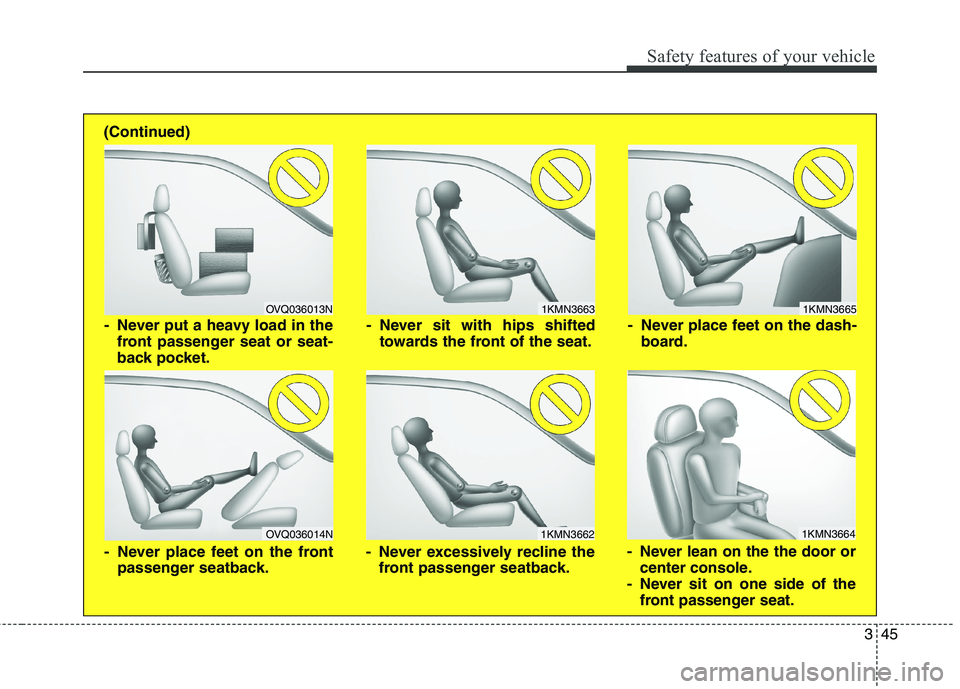
345
Safety features of your vehicle
1KMN3663
1KMN3664
1KMN3665
- Never sit with hips shifted
towards the front of the seat.
- Never lean on the the door or
center console.
- Never sit on one side of the
front passenger seat. - Never place feet on the dash-
board.
OVQ036013N
1KMN3662
- Never put a heavy load in the
front passenger seat or seat-
back pocket.
- Never excessively recline the
front passenger seatback.
OVQ036014N
- Never place feet on the front
passenger seatback. (Continued)
Page 67 of 438
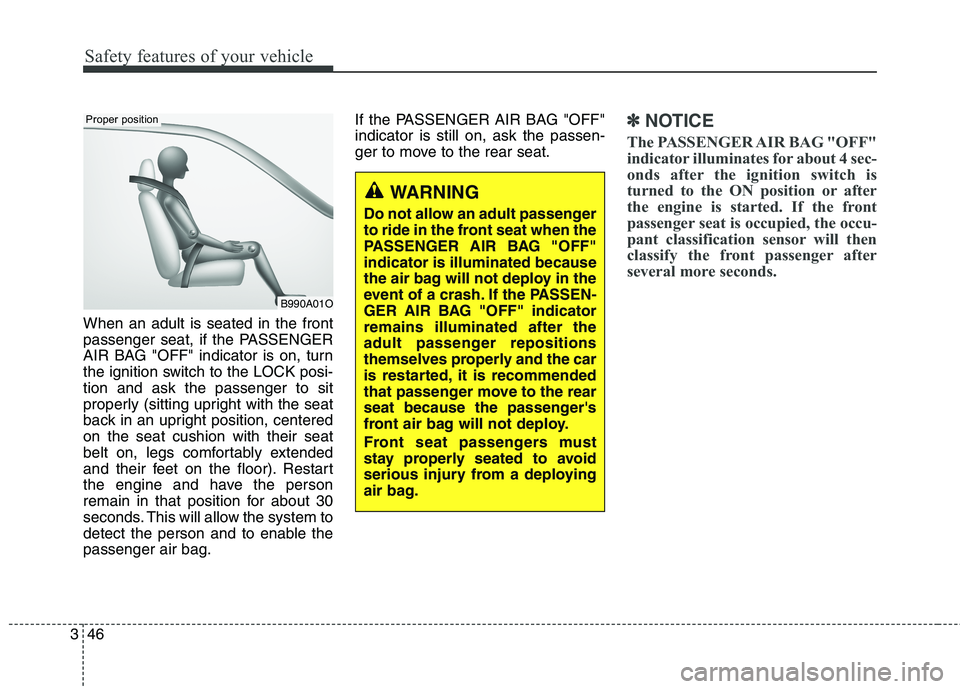
Safety features of your vehicle
46 3
When an adult is seated in the front
passenger seat, if the PASSENGER
AIR BAG "OFF" indicator is on, turn
the ignition switch to the LOCK posi-
tion and ask the passenger to sit
properly (sitting upright with the seat
back in an upright position, centered
on the seat cushion with their seat
belt on, legs comfortably extended
and their feet on the floor). Restart
the engine and have the person
remain in that position for about 30
seconds. This will allow the system to
detect the person and to enable the
passenger air bag.If the PASSENGER AIR BAG "OFF"
indicator is still on, ask the passen-
ger to move to the rear seat.
✽ ✽
NOTICE
The PASSENGER AIR BAG "OFF"
indicator illuminates for about 4 sec-
onds after the ignition switch is
turned to the ON position or after
the engine is started. If the front
passenger seat is occupied, the occu-
pant classification sensor will then
classify the front passenger after
several more seconds.
B990A01O
WARNING
Do not allow an adult passenger
to ride in the front seat when the
PASSENGER AIR BAG "OFF"
indicator is illuminated because
the air bag will not deploy in the
event of a crash. If the PASSEN-
GER AIR BAG "OFF" indicator
remains illuminated after the
adult passenger repositions
themselves properly and the car
is restarted, it is recommended
that passenger move to the rear
seat because the passenger's
front air bag will not deploy.
Front seat passengers must
stay properly seated to avoid
serious injury from a deploying
air bag.
Proper position
Page 68 of 438
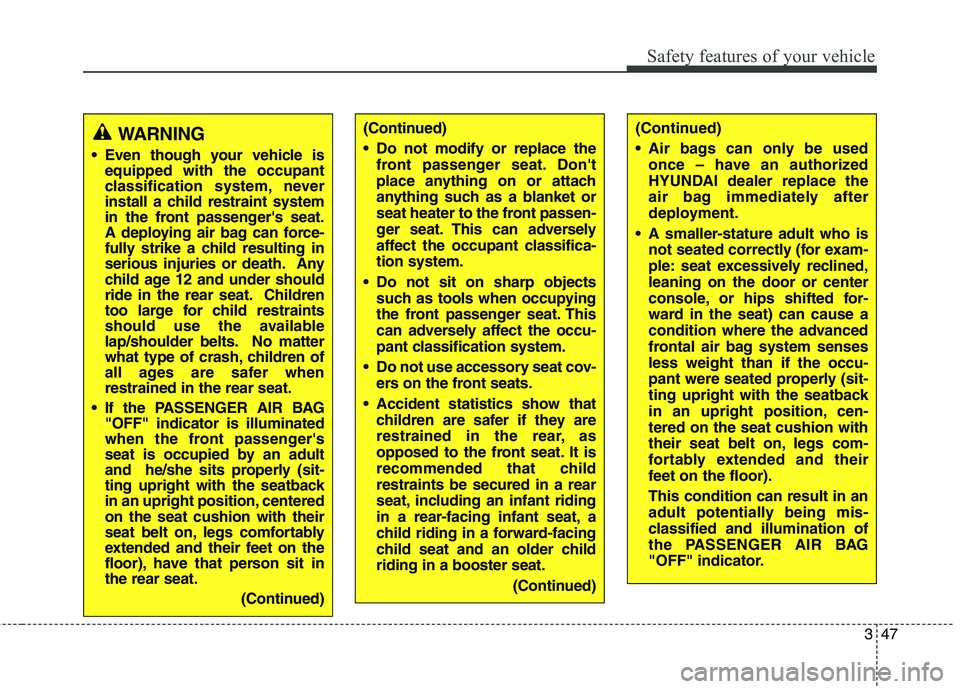
347
Safety features of your vehicle
(Continued)
Air bags can only be used
once – have an authorized
HYUNDAI dealer replace the
air bag immediately after
deployment.
A smaller-stature adult who is
not seated correctly (for exam-
ple: seat excessively reclined,
leaning on the door or center
console, or hips shifted for-
ward in the seat) can cause a
condition where the advanced
frontal air bag system senses
less weight than if the occu-
pant were seated properly (sit-
ting upright with the seatback
in an upright position, cen-
tered on the seat cushion with
their seat belt on, legs com-
fortably extended and their
feet on the floor).
This condition can result in an
adult potentially being mis-
classified and illumination of
the PASSENGER AIR BAG
"OFF" indicator.(Continued)
Do not modify or replace the
front passenger seat. Don't
place anything on or attach
anything such as a blanket or
seat heater to the front passen-
ger seat. This can adversely
affect the occupant classifica-
tion system.
Do not sit on sharp objects
such as tools when occupying
the front passenger seat. This
can adversely affect the occu-
pant classification system.
Do not use accessory seat cov-
ers on the front seats.
Accident statistics show that
children are safer if they are
restrained in the rear, as
opposed to the front seat. It is
recommended that child
restraints be secured in a rear
seat, including an infant riding
in a rear-facing infant seat, a
child riding in a forward-facing
child seat and an older child
riding in a booster seat.
(Continued)WARNING
Even though your vehicle is
equipped with the occupant
classification system, never
install a child restraint system
in the front passenger's seat.
A deploying air bag can force-
fully strike a child resulting in
serious injuries or death. Any
child age 12 and under should
ride in the rear seat. Children
too large for child restraints
should use the available
lap/shoulder belts. No matter
what type of crash, children of
all ages are safer when
restrained in the rear seat.
If the PASSENGER AIR BAG
"OFF" indicator is illuminated
when the front passenger's
seat is occupied by an adult
and he/she sits properly (sit-
ting upright with the seatback
in an upright position, centered
on the seat cushion with their
seat belt on, legs comfortably
extended and their feet on the
floor), have that person sit in
the rear seat.
(Continued)
Page 69 of 438
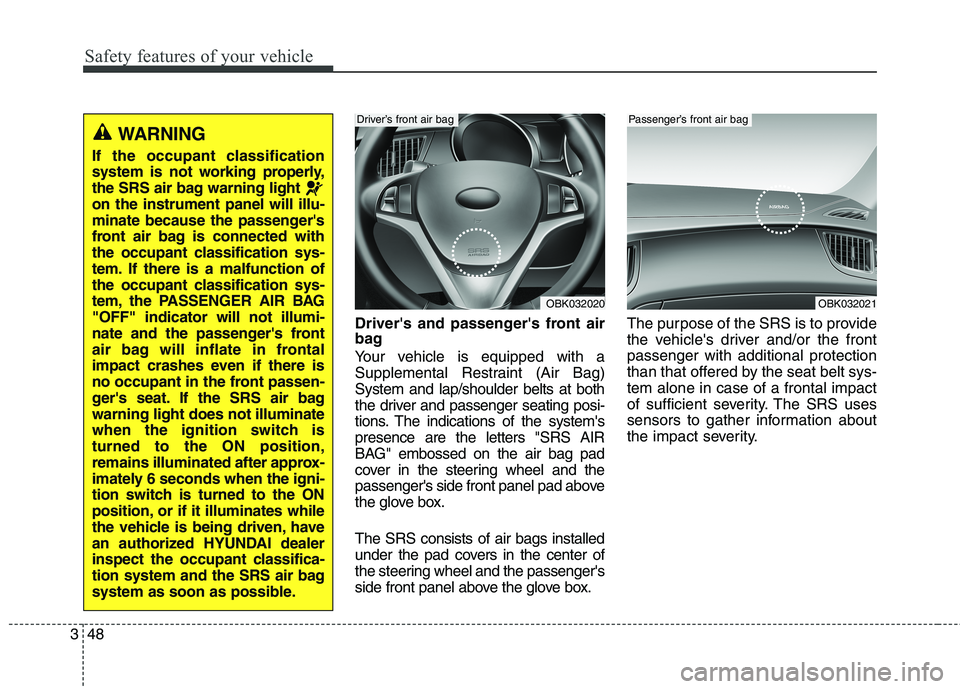
Safety features of your vehicle
48 3
Driver's and passenger's front air
bag
Your vehicle is equipped with a
Supplemental Restraint (Air Bag)
System and lap/shoulder belts at both
the driver and passenger seating posi-
tions. The indications of the system's
presence are the letters "SRS AIR
BAG" embossed on the air bag pad
cover in the steering wheel and the
passenger's side front panel pad above
the glove box.
The SRS consists of air bags installed
under the pad covers in the center of
the steering wheel and the passenger's
side front panel above the glove box.The purpose of the SRS is to provide
the vehicle's driver and/or the front
passenger with additional protection
than that offered by the seat belt sys-
tem alone in case of a frontal impact
of sufficient severity. The SRS uses
sensors to gather information about
the impact severity.
WARNING
If the occupant classification
system is not working properly,
the SRS air bag warning light
on the instrument panel will illu-
minate because the passenger's
front air bag is connected with
the occupant classification sys-
tem. If there is a malfunction of
the occupant classification sys-
tem, the PASSENGER AIR BAG
"OFF" indicator will not illumi-
nate and the passenger's front
air bag will inflate in frontal
impact crashes even if there is
no occupant in the front passen-
ger's seat. If the SRS air bag
warning light does not illuminate
when the ignition switch is
turned to the ON position,
remains illuminated after approx-
imately 6 seconds when the igni-
tion switch is turned to the ON
position, or if it illuminates while
the vehicle is being driven, have
an authorized HYUNDAI dealer
inspect the occupant classifica-
tion system and the SRS air bag
system as soon as possible.
OBK032020
Driver’s front air bag
OBK032021
Passenger’s front air bag
Page 70 of 438
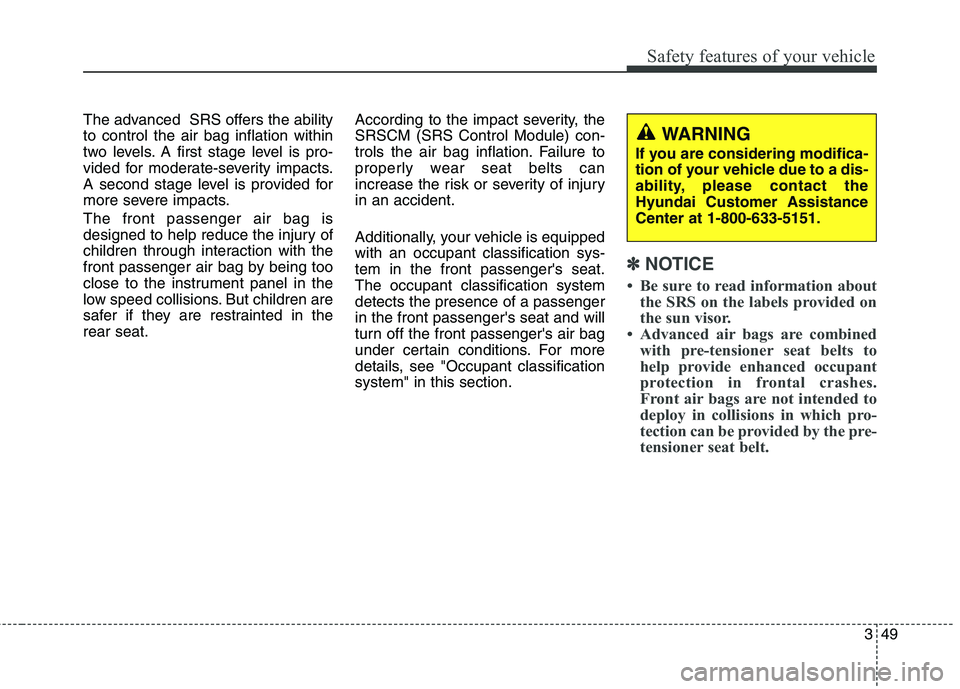
349
Safety features of your vehicle
The advanced SRS offers the ability
to control the air bag inflation within
two levels. A first stage level is pro-
vided for moderate-severity impacts.
A second stage level is provided for
more severe impacts.
The front passenger air bag is
designed to help reduce the injury of
children through interaction with the
front passenger air bag by being too
close to the instrument panel in the
low speed collisions. But children are
safer if they are restrainted in the
rear seat.According to the impact severity, the
SRSCM (SRS Control Module) con-
trols the air bag inflation. Failure to
properly wear seat belts can
increase the risk or severity of injury
in an accident.
Additionally, your vehicle is equipped
with an occupant classification sys-
tem in the front passenger's seat.
The occupant classification system
detects the presence of a passenger
in the front passenger's seat and will
turn off the front passenger's air bag
under certain conditions. For more
details, see "Occupant classification
system" in this section.
✽ ✽
NOTICE
• Be sure to read information about
the SRS on the labels provided on
the sun visor.
• Advanced air bags are combined
with pre-tensioner seat belts to
help provide enhanced occupant
protection in frontal crashes.
Front air bags are not intended to
deploy in collisions in which pro-
tection can be provided by the pre-
tensioner seat belt.
WARNING
If you are considering modifica-
tion of your vehicle due to a dis-
ability, please contact the
Hyundai Customer Assistance
Center at 1-800-633-5151.